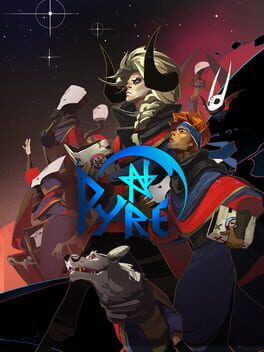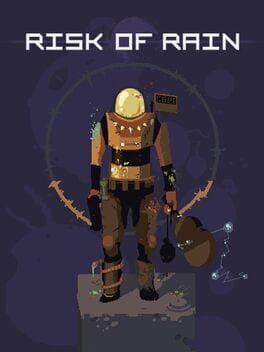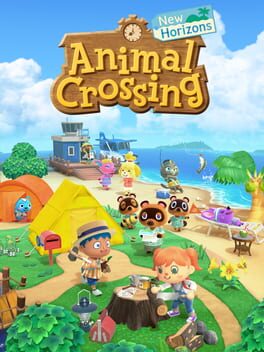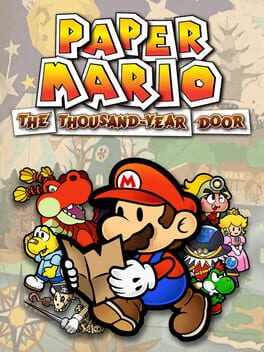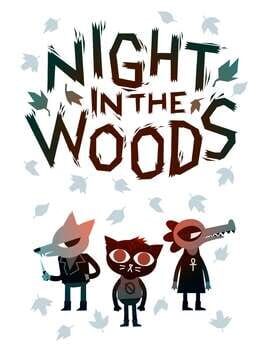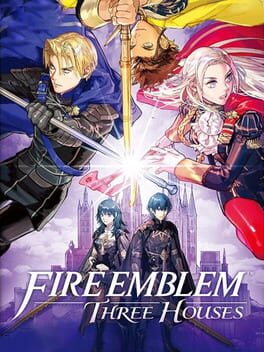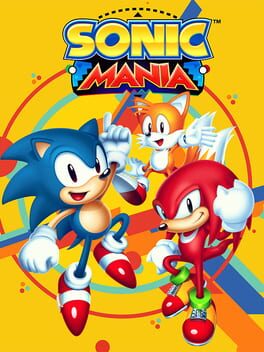VioletN
2017
Prior to Hades, Pyre was my favorite Supergiant game, and I still have a lot of love for it. As is standard for Supergiant, the aesthetics are the real standout here. The graphics are gorgeous, resembling a painted mural, rich in color in a way that's fantastical and otherworldly. The celestial motifs that persist throughout the game - the constellations that your roaming band of exiles use to navigate between each Rite location, for example - also serve to contribute to this feeling. As always, Darren Korb's soundtrack is excellent, blending various folk styles as well as some more out-there things like "pirate rock" or "baroque harpsichord music with hip hop beats". The other great thing about the game is its ensemble cast, which includes tons of memorable allies and adversaries, including my favorite character Rukey Greentail, a wry smuggler who is also a dog with a mustache.
But the most interesting part of the game is the Rites, which are essentially a magical basketball league in which exiles compete for the ability to break free of the purgatorial Downside and return to civilized society. Unlike most games, you don't receive a Game Over when you lose - the plot will continue, changing to reflect the outcome of each match. This determines which of the several opposing teams you will face in the final "Liberation Rite" of each "season". Whichever team wins the Liberation Rite will get to choose one teammate to free from exile. This is fascinating to me, because once you free a teammate, they are gone forever, unable to be used or interacted with for the rest of the game. Depending on the outcome of each match, this can drastically change your team's makeup as the game goes on. Losing a liberation rite means your opponent will go free instead - which might be good or bad thing depending on who said opponent is. It could be Dalbert, a kindly old dog with a sense of piety, or it could be someone like H. Manley Tinderstauf, a stuck-up aristocratic tree who everyone in the game despises. It's always bittersweet setting someone free from exile - you want them to be able to return to their loved ones back in the normal world, but at the same time their absence will be deeply felt by all those left stuck in the Downside.
Each opposing team has its own leader character with their own reasons for their exile, and motivations for what they plan on doing once they return back home. They also each have a connection to one of the members of your own team. Each time you face off against a team, these interpersonal storylines progress in interesting ways, with variable results based on whether you win or lose. It's an excellent way of writing a sports game with an ensemble cast and a character-driven plot.
Although some people might not like the sports gameplay, I found it very enjoyable, especially since it's tied so heavily to the story progression. There is very little I can complain about with regards to Pyre - it's simply a fantastic game.
But the most interesting part of the game is the Rites, which are essentially a magical basketball league in which exiles compete for the ability to break free of the purgatorial Downside and return to civilized society. Unlike most games, you don't receive a Game Over when you lose - the plot will continue, changing to reflect the outcome of each match. This determines which of the several opposing teams you will face in the final "Liberation Rite" of each "season". Whichever team wins the Liberation Rite will get to choose one teammate to free from exile. This is fascinating to me, because once you free a teammate, they are gone forever, unable to be used or interacted with for the rest of the game. Depending on the outcome of each match, this can drastically change your team's makeup as the game goes on. Losing a liberation rite means your opponent will go free instead - which might be good or bad thing depending on who said opponent is. It could be Dalbert, a kindly old dog with a sense of piety, or it could be someone like H. Manley Tinderstauf, a stuck-up aristocratic tree who everyone in the game despises. It's always bittersweet setting someone free from exile - you want them to be able to return to their loved ones back in the normal world, but at the same time their absence will be deeply felt by all those left stuck in the Downside.
Each opposing team has its own leader character with their own reasons for their exile, and motivations for what they plan on doing once they return back home. They also each have a connection to one of the members of your own team. Each time you face off against a team, these interpersonal storylines progress in interesting ways, with variable results based on whether you win or lose. It's an excellent way of writing a sports game with an ensemble cast and a character-driven plot.
Although some people might not like the sports gameplay, I found it very enjoyable, especially since it's tied so heavily to the story progression. There is very little I can complain about with regards to Pyre - it's simply a fantastic game.
2013
Much like The Binding of Isaac: Rebirth, this is another roguelike that I put over a hundred hours into before realizing that I really didn't like it. My major complaint is how slow and laborious the gameplay feels - until you get a decent number of speed upgrades, you hobble around each level at a snail's pace engaging in boring combat with enemies that take too long to die. The most captivating part of the game is its upgrade system, which allows you to stack multiple copies of the same upgrade for enhanced effects. However, although there is some satisfaction in getting a ton of useful upgrades, it only partially obscures the fact that the core gameplay is extremely boring. The levels are incredibly samey and involve doing the same exact stuff over and over again, and they also look incredibly bland with little in terms of decoration. After doing a four hour long run where I beat the final boss several times, I came to realize that the only enjoyment I got out of the game was the possibility of becoming extremely powerful after stacking a bunch of upgrades. Once I had felt what that was like, I no longer had any desire to play it, which is awful for a roguelike. It's just a totally bland and uninspired 2D shooter game.
What the hell does "Risk of Rain" even mean?
What the hell does "Risk of Rain" even mean?
2015
Nuclear Throne is Vlambeer in its element - a fast, crunchy projectile-saturated shoot 'em up roguelike. Unlike many roguelikes, it's not really focused on "builds" - there are upgrades, yes, but these upgrades are rather rudimentary things like "move faster" or "have more max health". The simplicity works well for the game, though, since the focus is meant to be on the combat itself. There's a lot of weapons in the game, most of which are pretty fun to use, especially when paired with certain characters' special abilities and late-game Ultra Mutations. The ability to loop through the game after reaching the titular Nuclear Throne adds a fun amount of replayability to the whole thing, especially since it only takes a handful of minutes to get there. All in all, this is a very solid title.
Animal Crossing games are kind of hard to rate, because they're very much the definition of "make your own fun". There isn't really much of a progression loop in them besides just fishing and catching bugs and selling turnips in order to get more bells to pay off your house loan with. However, the reason why I like New Horizons is precisely because it gives you a bunch of tools to make your own fun with. The Island Designer mechanics offer something that I've always wanted from an Animal Crossing game: the ability to shape my town's entire layout, placing cliffs and rivers wherever I want them. The amount of customization on offer is invigorating, and I greatly enjoyed being able to convert my island into a cozy town full of cliffsides and waterfalls and fill it with furniture of my choosing. I just wish it was easier to choose which villagers you want in your town.
Mario RPGs are known for telling funny stories with quirky characters in strange locales, and it becomes clear that Paper Mario: The Thousand Year Door is no exception the moment you set foot in Rogueport, the game's hub world. A far cry from the idyllic Toad Towns of other games, Rogueport is a graffiti-covered seedy merchant port full of salty dogs and criminals who don't know or care who Mario is. One of the first things you see is a huge noose set up in the town square. While talking to your first partner, Goombella, if you look into the background you can see two Piantas, the goofy plant people from Super Mario Sunshine (who run a Mafia-style organized crime syndicate in this game, of course) roughing up some poor shmuck and leaving him crumpled in the street. Walk one screen to the right and Mario will get half of his coins stolen by a bandit who pulls off a fly-by mugging on him.
Thousand Year Door feels like a real adventure, a journey into treacherous unknown lands. It's divided into eight chapters, and each one involves an exciting excursion to some new corner of the country where you'll meet new characters and inevitably get dragged into some sort of fiasco. One chapter has Mario and his partners essentially become pro wrestlers, duking it out in the Glitz Pit arena for a chance of getting the mystical Crystal Star attached to the champion's belt - the champion, of course, being a Hulk Hogan-esque hawk who ruthlessly shit-talks you at every occasion. In another chapter, you travel to a haunted, twilight-drenched town where a shapeshifting bedsheet ghost has taken up residence in the nearby chapel, turning another villager into a pig every time the bell tolls.
Although the game isn't free from its faults - excessive backtracking being one of the major ones - it's full of charm at every corner, and it's always a delight to see what each new turn will bring. The character designs are also particularly deserving of praise, managing to look very unique and interesting while still fitting into the Mario style. The amount of care put into the game's presentation helps make each location feel lively and exciting to explore.
Thousand Year Door feels like a real adventure, a journey into treacherous unknown lands. It's divided into eight chapters, and each one involves an exciting excursion to some new corner of the country where you'll meet new characters and inevitably get dragged into some sort of fiasco. One chapter has Mario and his partners essentially become pro wrestlers, duking it out in the Glitz Pit arena for a chance of getting the mystical Crystal Star attached to the champion's belt - the champion, of course, being a Hulk Hogan-esque hawk who ruthlessly shit-talks you at every occasion. In another chapter, you travel to a haunted, twilight-drenched town where a shapeshifting bedsheet ghost has taken up residence in the nearby chapel, turning another villager into a pig every time the bell tolls.
Although the game isn't free from its faults - excessive backtracking being one of the major ones - it's full of charm at every corner, and it's always a delight to see what each new turn will bring. The character designs are also particularly deserving of praise, managing to look very unique and interesting while still fitting into the Mario style. The amount of care put into the game's presentation helps make each location feel lively and exciting to explore.
2017
Night in the Woods is simply an incredible game, one that gives off the feeling of settling down with a really good book. A lot of games that seriously focus on the state of our world and our societal issues can often feel a bit preachy or overwrought, but Night in the Woods pulls it off seemingly effortlessly. It perfectly captures the feeling of living in a world that is crumbling around you, where sometimes all you want to do is goof off with your friends, because the issues are too big for any one person to handle. There's this nagging feeling of existential despair hanging over the game, but it starts at the margins, just out of sight.
The opening acts of the story have a very cozy, almost Animal Crossing-esque vibe, as you become accustomed to the town of Possum Springs and settle into a daily routine. The recurring characters who appear each day imbue the town with life, and as the game goes on the amount of locations to check on each day increases. Although the platforming isn't super sophisticated, it's enough to make you feel as free and rambunctious as Mae does when she's running about through town. You begin to feel a hint of the stability that Mae was searching for when she dropped out of college, but it's tinged with a bit of sadness - her old friend Casey is gone, Bea seems to hate her guts for some reason, and Gregg is forming his own plans with his boyfriend Angus. Possum Springs is changing, and in some ways declining.
As the autumn progresses, you can palpably feel the slow shift in tone as Mae's mental health begins to take a toll, and more and more seemingly supernatural elements creep into the story. The middle quarters of the game are peppered with wonderfully surreal dream sequences in neon blue and pink that seem to wordlessly hint at the emotional and existential turmoil going on within Mae's head. It's these creepy elements that inform much of Night in the Wood's unique tone, and by the end of the game they are perfectly married to the game's themes about what it means to live in a society where people are only valued for their labor and the systems we uphold are designed to be able to crush us at a moment's notice.
Mae is just a normal person, a twenty-something year old with no job who couldn't handle the stress of college. She's not a hero who can fix the world, or even fix her friends' economic and interpersonal struggles. There are tons of moments in the game in which you are given dialogue options where neither options are the "right" thing to say, because Mae's social awkwardness makes it hard for her to navigate heavy conversations. One particularly memorable moment near the beginning of the game involves a drunk Mae attempting to apologize to Bea for her behavior; the dialogue options are perfectly formulated, formal apologies, but when picked they only come out as half-coherent drunken sobs. The message here is that Mae is her own person with her own flaws, and no about of omniscient guidance on the part of the player can change that.
The extent of the player's control comes from how they choose to spend Mae's time, both in terms of exploring Possum Springs and in terms of which of the main characters they choose to hang out with. There are tons of scenes and conversations in the game that are totally missable depending on what you do while playing the game. None of these change the overall outcome of the game, and yet there's still a powerful incentive to seek them out - namely, that the writing in the game is extremely good. The characters are relatable and well-rounded and funny - funny like how your friends are funny, not like a Joss Whedon character making cool quips or something. My favorite is Bea, Mae's depressed goth friend who truly cares for her deep down, but there's also a lot to love about Gregg's hyperactive criminal antics or Angus's quiet, understated sense of humor. Through your various hangout sessions and the IM messages you exchange with them on your computer each night, you begin to genuinely appreciate who these people are, and feel for their struggles, which are all too relatable to so many of us these days.
I would be remiss to not mention the artstyle and music, which are both excellent. The art is simple yet pleasing and evocative, capturing both the warmth of Possum Springs as well as the dark and eerie undercurrent that pervades the game's playtime. The music is also, uh, simple yet pleasing and evocative, calming and catchy and full of little leitmotifs that truly help tie the story together. The whole experience of playing Night in the Woods is strangely immersive in this regard, filling you with a potent mix of emotions that is hard to describe. You begin to feel like you truly occupy Mae's shoes; her home becomes your home, and her friends become your friends. Few games have made me feel such powerful emotions as this one, and much like a good book, I find myself longing to return to it and experience the story again.
Also, I want Mae and Bea to kiss.
The opening acts of the story have a very cozy, almost Animal Crossing-esque vibe, as you become accustomed to the town of Possum Springs and settle into a daily routine. The recurring characters who appear each day imbue the town with life, and as the game goes on the amount of locations to check on each day increases. Although the platforming isn't super sophisticated, it's enough to make you feel as free and rambunctious as Mae does when she's running about through town. You begin to feel a hint of the stability that Mae was searching for when she dropped out of college, but it's tinged with a bit of sadness - her old friend Casey is gone, Bea seems to hate her guts for some reason, and Gregg is forming his own plans with his boyfriend Angus. Possum Springs is changing, and in some ways declining.
As the autumn progresses, you can palpably feel the slow shift in tone as Mae's mental health begins to take a toll, and more and more seemingly supernatural elements creep into the story. The middle quarters of the game are peppered with wonderfully surreal dream sequences in neon blue and pink that seem to wordlessly hint at the emotional and existential turmoil going on within Mae's head. It's these creepy elements that inform much of Night in the Wood's unique tone, and by the end of the game they are perfectly married to the game's themes about what it means to live in a society where people are only valued for their labor and the systems we uphold are designed to be able to crush us at a moment's notice.
Mae is just a normal person, a twenty-something year old with no job who couldn't handle the stress of college. She's not a hero who can fix the world, or even fix her friends' economic and interpersonal struggles. There are tons of moments in the game in which you are given dialogue options where neither options are the "right" thing to say, because Mae's social awkwardness makes it hard for her to navigate heavy conversations. One particularly memorable moment near the beginning of the game involves a drunk Mae attempting to apologize to Bea for her behavior; the dialogue options are perfectly formulated, formal apologies, but when picked they only come out as half-coherent drunken sobs. The message here is that Mae is her own person with her own flaws, and no about of omniscient guidance on the part of the player can change that.
The extent of the player's control comes from how they choose to spend Mae's time, both in terms of exploring Possum Springs and in terms of which of the main characters they choose to hang out with. There are tons of scenes and conversations in the game that are totally missable depending on what you do while playing the game. None of these change the overall outcome of the game, and yet there's still a powerful incentive to seek them out - namely, that the writing in the game is extremely good. The characters are relatable and well-rounded and funny - funny like how your friends are funny, not like a Joss Whedon character making cool quips or something. My favorite is Bea, Mae's depressed goth friend who truly cares for her deep down, but there's also a lot to love about Gregg's hyperactive criminal antics or Angus's quiet, understated sense of humor. Through your various hangout sessions and the IM messages you exchange with them on your computer each night, you begin to genuinely appreciate who these people are, and feel for their struggles, which are all too relatable to so many of us these days.
I would be remiss to not mention the artstyle and music, which are both excellent. The art is simple yet pleasing and evocative, capturing both the warmth of Possum Springs as well as the dark and eerie undercurrent that pervades the game's playtime. The music is also, uh, simple yet pleasing and evocative, calming and catchy and full of little leitmotifs that truly help tie the story together. The whole experience of playing Night in the Woods is strangely immersive in this regard, filling you with a potent mix of emotions that is hard to describe. You begin to feel like you truly occupy Mae's shoes; her home becomes your home, and her friends become your friends. Few games have made me feel such powerful emotions as this one, and much like a good book, I find myself longing to return to it and experience the story again.
Also, I want Mae and Bea to kiss.
This review contains spoilers
Prior to Three Houses, the only Fire Emblems I’d played were Awakening and Fates: Conquest. I thought Awakening was a boring slog, but I liked the tight and challenging gameplay of Conquest, as well as certain aspects of the plot. I mean, taken as a whole, the plot of Conquest was kinda bad, but there were parts of it that I felt contained interesting ideas that I wish had been expanded upon more. Unlike Awakening, you weren’t exclusively fighting against cartoon villains - you were also fighting Hoshido, the archetypical good guy hero squad faction. The coolest moments in that game came from the emotional weight of fighting decent people thrust into a cruel war.
Three Houses takes that aspect of the plot and just runs with it. And unlike Fates, it actually gives you over half of the game to get to know the characters around the school before a war breaks out and forces you to fight and maybe even kill the people you once studied and trained with. This war isn’t the result of some evil king bent on world conquest, but rather a consequence of Fodlan’s broken system of crests and nobility. Edelgard, a revolutionary leader, wants to overthrow this system and the gods in order to create a world for humanity - however, of course, this path is one of conquest and bloodshed, and so it is met with opposition from the other factions, especially the Kingdom as led by Dimitri, who is so shell-shocked by the violence that massacred his family and the Duscur people that he is unable to see Edelgard as anything other than a monstrous tyrant.
This plot might not be groundbreaking, but it’s a huge step above the other Fire Emblem games I’ve played. Each faction has its own political and moral beliefs that drive its actions, and no matter which one you choose you won’t see every side of the story in one playthrough. If you side with Dimitri, who is obsessed with the past, you’ll learn about his history with Edelgard and the events that made him who he is today. This information isn’t shown to you at all on Edelgard’s route, because she’s constantly moving on from the past and who she was before. Instead, on her route you get to learn more about her true enemy, the Church of Seiros, and their crazy hot pope Lady Rhea. The way the game divvies up this information between routes and intentionally colors the player’s worldview - even outright lying to them at points - is a really clever way of showing how all factions in a war are only operating based on what they think they know, which can have tragic consequences.
The story has flaws, of course, and sometimes can be a bit cheesy or feel a bit rushed - Edelgard’s route is pretty short and low on animated cutscenes, although it is still one of the most unique routes in the game. However, the two routes I played, Edelgard’s and Dimitri’s, really stuck the landing with their ending cutscenes, the former because of the sheer exhilaration of winning the revolution in such a spectacular way, and the latter because of how much it manages to communicate about the focal characters with basically no dialogue at all, a particularly impressive bit of storytelling from a game that can be rather on the nose at times.
The music and voice acting in the game are all excellent, a delight to listen to all throughout. Chris Hackney, the voice of Dimitri, deserves especial praise for how well he handles his role and the amount of range he gives his character. Other small touches - like how the UI changes after the timeskip as well as the way new chapters are presented - go a long way to enhance the way the game feels. The gameplay isn’t quite as good as Conquest’s, but it’s still pretty fun. Lastly, I have to say I’m very glad that the horny content has been toned way down compared to the previous games. There’s obviously still some sexualized characters in the game, but the majority of them are reasonably dressed.
All in all, I would consider Three Houses a great game and I’m glad that I played it.
Three Houses takes that aspect of the plot and just runs with it. And unlike Fates, it actually gives you over half of the game to get to know the characters around the school before a war breaks out and forces you to fight and maybe even kill the people you once studied and trained with. This war isn’t the result of some evil king bent on world conquest, but rather a consequence of Fodlan’s broken system of crests and nobility. Edelgard, a revolutionary leader, wants to overthrow this system and the gods in order to create a world for humanity - however, of course, this path is one of conquest and bloodshed, and so it is met with opposition from the other factions, especially the Kingdom as led by Dimitri, who is so shell-shocked by the violence that massacred his family and the Duscur people that he is unable to see Edelgard as anything other than a monstrous tyrant.
This plot might not be groundbreaking, but it’s a huge step above the other Fire Emblem games I’ve played. Each faction has its own political and moral beliefs that drive its actions, and no matter which one you choose you won’t see every side of the story in one playthrough. If you side with Dimitri, who is obsessed with the past, you’ll learn about his history with Edelgard and the events that made him who he is today. This information isn’t shown to you at all on Edelgard’s route, because she’s constantly moving on from the past and who she was before. Instead, on her route you get to learn more about her true enemy, the Church of Seiros, and their crazy hot pope Lady Rhea. The way the game divvies up this information between routes and intentionally colors the player’s worldview - even outright lying to them at points - is a really clever way of showing how all factions in a war are only operating based on what they think they know, which can have tragic consequences.
The story has flaws, of course, and sometimes can be a bit cheesy or feel a bit rushed - Edelgard’s route is pretty short and low on animated cutscenes, although it is still one of the most unique routes in the game. However, the two routes I played, Edelgard’s and Dimitri’s, really stuck the landing with their ending cutscenes, the former because of the sheer exhilaration of winning the revolution in such a spectacular way, and the latter because of how much it manages to communicate about the focal characters with basically no dialogue at all, a particularly impressive bit of storytelling from a game that can be rather on the nose at times.
The music and voice acting in the game are all excellent, a delight to listen to all throughout. Chris Hackney, the voice of Dimitri, deserves especial praise for how well he handles his role and the amount of range he gives his character. Other small touches - like how the UI changes after the timeskip as well as the way new chapters are presented - go a long way to enhance the way the game feels. The gameplay isn’t quite as good as Conquest’s, but it’s still pretty fun. Lastly, I have to say I’m very glad that the horny content has been toned way down compared to the previous games. There’s obviously still some sexualized characters in the game, but the majority of them are reasonably dressed.
All in all, I would consider Three Houses a great game and I’m glad that I played it.
2017
I'm not really a huge fan of Metroidvanias - the genre doesn't usually click with me, as someone who gets stressed out about getting lost in games. However, Hollow Knight won me over with its charming aesthetics, lovely soundtrack, and fun, challenging combat. The thing that makes it work is that once you've gotten past the opening stages of the game, it really opens up. It's hard to get stuck with no idea of what to do because there's always several avenues open to you. Finding a secret or getting a new powerup that expands your mobility is always such an exhilarating feeling. Few thrills compare to when I finally gained the ability to get past those shadowy gates I kept seeing around the map, or when I found out how to access the east side of the City of Tears. There's a real sense of beauty to this game, even in the gloomy darkness of Hallownest. The first time I entered the City of Tears and heard the music begin to play, I was enthralled by it, and sat on the bench watching the rain fall while soaking in the atmosphere. That's the moment that has stuck with me the most.
I'm very excited to play Silksong when it comes out.
I'm very excited to play Silksong when it comes out.
I have long compared The Binding of Isaac to a slot machine, which maybe isn't quite fair. Unlike a slot machine, there is a decent amount of skill involved - understanding the mechanics, learning how to get deals with the devil, figuring out what synergizes with what. But at the end of the day, those flashy synergies are really the only draw of the game, and the only reason why I have a little over 150 hours in it. There's only so many times I can completely annihilate everything with screen-spanning laser beams before it starts becoming a chore. Isaac fails at what I'd consider the most important part of a roguelike - being challenging but fair. In Isaac, there is rarely a moment in which you feel like you are having a fun challenge. You are either insanely overpowered and nuking all of the bosses in less than 10 seconds, or you are the weakest baby alive, spending each encounter strafing around the arena for several minutes while doing a piddling amount of damage. It doesn't feel satisfying to attack and kill enemies until you've gotten enough items that the game starts to play itself. And on top of it all, most of the soundtrack is made up of boring atmospheric tracks, which is not what I want to be listening to when playing an action roguelike. At least some of the boss themes like "Infanticide" are good.
2018
When I picked up Hades in late June of 2020, I was worried that I wouldn't really be able to sink my teeth into it. Four months later, I have almost 200 hours in the game. Supergiant Games really perfected the roguelike gameplay loop here. Like many roguelikes, every run, you get a plethora of resources that will help you become stronger and unlock new skills and trinkets. However, what takes Hades a step beyond that is the way it integrates narrative into the experience. Dying is rarely frustrating because each death allows you to spend more time in your home, the House of Hades, where you can interact with the many affable characters who live there and build relationships with them. There's a metric ton of dialogue in this game, to the point where you'll still be seeing new lines even after beating the game dozens of times. The way the lategame and postgame is handled is also excellent, allowing the player to gradually increase the difficulty to the level they desire in exchange for special rewards that will make their weapons even stronger. The sheer amount of weapon, upgrade, and talent combinations allows for an enormous variety in builds, nearly all of which are incredible. There are very few things in the game that are actually weak - even the stuff that isn't universally good is at least situationally good with certain builds. That, more than anything, is why I keep coming back to Hades time and time again.
2017
Although I didn't have a Sega Genesis, I played the Sonic Mega Collection on the Gamecube a lot as a kid, so I do have a lot of fondness for the classic Sonic games, even though recent replays of them have exposed a lot of their flaws. Sonic Mania is like if you took someone's unexamined nostalgic memories of Classic Sonic and turned them into a game, and because of that it totally kicks ass. There's clearly a lot of love for the originals here, but there's also a lot of innovation and new mechanics. The levels are sprawling and full of branching paths, and genuinely really fun to attempt to speedrun, even casually. When a Sonic game gets me to actually use the Time Attack mode, that's a sign that it's doing something right. One of Sonic's best qualities compared to Mario has always been the uniqueness of its level environments, and that's definitely the case here. My favorite world has got to be the one that's a printing press factory located inside a wintery Japanese forest, but the vine-covered Roman cityscape of Stardust Speedway Act 1 is also just incredible to look at. Also, every single song on the soundtrack slaps.
2002
This game (rightfully) gets a lot of flak for its jankiness. And it is janky in a lot of regards; there's a lot of bafflingly obtuse levels, like the one where you have to collect red coins in a pachinko machine with positively Euclidean physics. However, at the same time, Sunshine does an amazing job at creating a cohesive mood, a "vibe" if you will, in a way that none of the 3D Mario games do. I love how every world has its own unique spin on the tropical theme, and because they're all located in specific spots on the same island, it creates a sense of place. You get the sense that this is a physical location in the Mario universe, where people live their lives and go to for vacation. Because of that, it's just a blast to explore the levels searching for secrets, especially since Mario is incredibly mobile thanks to the addition of FLUDD and the spin jump. Also, for a Gamecube game released in 2002, it looks absolutely gorgeous - the water effects still hold up even today.
2015
In spite of all the jokes and various antics (which are mostly very amusing and charming!) there's still a pervasive feeling of bittersweetness that flows throughout the game, especially on my first playthrough where I accidentally killed the first boss. The thing I remember the most about that first playthrough was the loneliness of the trek through the underground, of meeting all these nice, lovable characters and then leaving them behind. When I saw the scene at New Home, it made me cry partly because of this loneliness, and partly because I felt guilty for the death I'd caused at the beginning of the game. To me, this is really the "true" Undertale experience, and I think too many people worry about doing a 100% pacifist run on their first playthrough, even though the game definitely sets you up to fail at it at least once...
Also, the OST still fills me with a powerfully wistful feeling. Toby Fox inspired me to start writing music myself, and now I'm pretty good at it, so I have a lot to thank him and this game for.
Also, the OST still fills me with a powerfully wistful feeling. Toby Fox inspired me to start writing music myself, and now I'm pretty good at it, so I have a lot to thank him and this game for.
